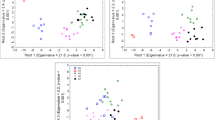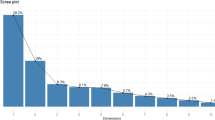Abstract
To determine the relative importance of the genotype, the environment, and their interaction on the expression of morphological characters in maize races, 50 Mexican races and 24 races from Central America, South America, and the U.S. were grown in several locations and seasons in México and 47 characters were measured directly. Estimates of the ratio of variance components, rc = [Vc/(Ve+VCs/], were used as criteria to determine the appropriate characters for racial classification. Twenty-four useful variables were identified. Analysis of the structure of the data matrix facilitated visual examination of correlations among the variables and of the variability represented by each variable. Based on these analyses, a minimum list of 9 characters was suggested to be appropriate variables for racial classification: number of leaves per plant, branched part length/tassel length, central spike internode length, male glume length, kernel width, rachis segment length, pith diameter, ear diameter/length, and kernel width/length.
Resumen
Con la finalidad de determinar la importancia relativa del genotipo, ambiente y su interacción, en la expresión de caracteres morfológicos de las razas de maíz, se llevó a cabo un estudio con 50 razas Mexicanas y 24 razas de América Central, América del Sur y Los Estados Unidos de América; dichas razas fueron sembradas en varias localidades y estaciones en México y 47 caracteres fueron medidos directamente. En base a la estimación de la relación de componentes de varianza, rc = [Vc/(Ve+ VCe/], como criterio para determinar los caracteres apropiados para clasificación racial, se identificaron 24 variables. El análisis de la estructura de la matriz de datos facilitó la examinación de las correlaciones y de la variabilidad representada por coda variable. En base a dichos andlisis, se puede sugerir una lista mínima de nueve caracteres, como variables apropiadas para clasificación racial: Número de hojas por planta, longitud de la parte ramificada/ longitud de espiga, longitud de entrenudos (separación entre pares de espiguillas) de la rama central de la espiga, longitud de gluma masculina, ancho de grano, longitud de segmento de raquis, diámetro de médula, diámetro/longitud de mazorca y ancho/longitud de grano.
Similar content being viewed by others
Literature Cited
Alava, R. O. 1952. Spikelet variation inZea mays L. Annals of the Missouri Botanical Garden 39:65–96.
Anderson, E. 1944. Homologies of the ear and tassel inZea mays. Annals of the Missouri Botanical Garden 31:325–343.
Anderson, E. 1951. The sacred plume. Pioneer Hi-Bred Corn Company, Des Moines, Iowa.
—,and H. C. Cutler. 1942. Races ofZea mays. I. Their recognition and classification. Annals of the Missouri Botanical Garden 29:69–88.
Benz, B. F. 1981. Five modern races of maize from northwestern México: archaeological implications. Unpublished M.A Thesis. University of Colorado. 113 p.
-. 1986. Taxonomy and evolution of Mexican maize. Unpublished Ph.D. Dissertation, University of Wisconsin, Madison. 433 p.
Bird, R. McK. 1984. South American maize in Central America? Pages 39–65in D. Stone, ed., Pre-Columbian plant migrations. Peabody Museum of Archaeology and Ethnology, Harvard University, Cambridge, MA.
Cervantes S., T. 1976. Efectos geneticos y de interactión genotipo-medio ambiente en la clasificación de las razas Mexicanas de maíz. Unpublished Ph.D. Dissertation, Colegio de Postgraduados, Chapingo, México. 139 p.
Doebley, J. F. 1980. The maize and teosinte male inflorescence: a numerical taxonomic study. Unpublished Ph.D. Dissertation. University of Wisconsin. 225 p.
—,and H. H. Ilris. 1980. Taxonomy ofZea I: subgeneric classification with key to taxa. American Journal of Botany 67:986–993.
Emigh, T. H., and M. M. Goodman. 1985. Multivariate analysis in nematode taxonomy. Pages 197–204in K. R. Barker, C. C. Carter, and J. N. Sasser, eds., An advanced treatise on Meloidogyne. Vol. II. Methodology. North Carolina State University Graphics, Raleigh, NC.
Goodman, M. M., and E. Paterniani. 1969. The races of maize. III. Choices of appropriate characters for racial classification. Economic Botany 23:265–273.
—,and W. L. Brown. 1988. Races of corn. Pages 33–79in G. F. Sprague and J. W. Dudley, eds., Corn and corn improvement. 3rd ed. Am. Soc. of Agron., Madison, WI.
—,and C. W. Stuber. 1983. Races of maize. VI. Isozyme variation among races of maize in Bolivia. Maydica 28:169–187.
Hallauer, A. R., and J. B. Miranda Fo. 1981. Quantitative genetics in maize breeding. Iowa State Univ. Press, Ames, IA
Iltis, H. H., and J. F. Doebley. 1980. Taxonomy ofZea (Gramineae). II. Subspecific categories in theZea mays complex and a generic synopsis. American Journal of Botany 67:994–1004.
Kempthorne, O. 1973. An introduction to genetic statistics. 2nd ed. Iowa State Press, Ames, IA.
Ortíz R., R. O. 1985. Efecto ambiental, interactión genotipo-medio ambiente y heredabilidad de las características morfológicas usadas en la clasificación racial de maíz en la Sierra del Perú. Unpublished M.S. Thesis. Univ. Agraria, La Molina, Perú. 90 p.
Rawlings, J. O. 1988. Applied regression analysis: a research tool. Wadsworth & Brooks/Cole Advanced Books & Software, Pacific Grove, CA.
Sanchez P., P. 1983. Estudio de estabilidad de caracteres y razas de maíz de México. Unpublished M.S. Thesis. Colegio de Postgraduados, Chapingo, México. 73 p.
Sanchez G., J. J. 1989. Relationships among the Mexican races of maize. Unpublished Ph.D. Dissertation. North Carolina State University, Raleigh, N.C. 187 p.
Wellhausen, E. J., L. M. Roberts, and E. Hernández X., con P. C. Mangelsdorf. 1951. Razas de maíz en México. Folleto Técnico No. 5. Oficina de Estudios Especiales, Secretaría de Agriculture y Ganadería. México.
Author information
Authors and Affiliations
Rights and permissions
About this article
Cite this article
Sánchez, J.J.G., Goodman, M.M. & Rawlings, J.O. Appropriate characters for racial classification in maize. Econ Bot 47, 44–59 (1993). https://doi.org/10.1007/BF02862205
Received:
Accepted:
Issue Date:
DOI: https://doi.org/10.1007/BF02862205




